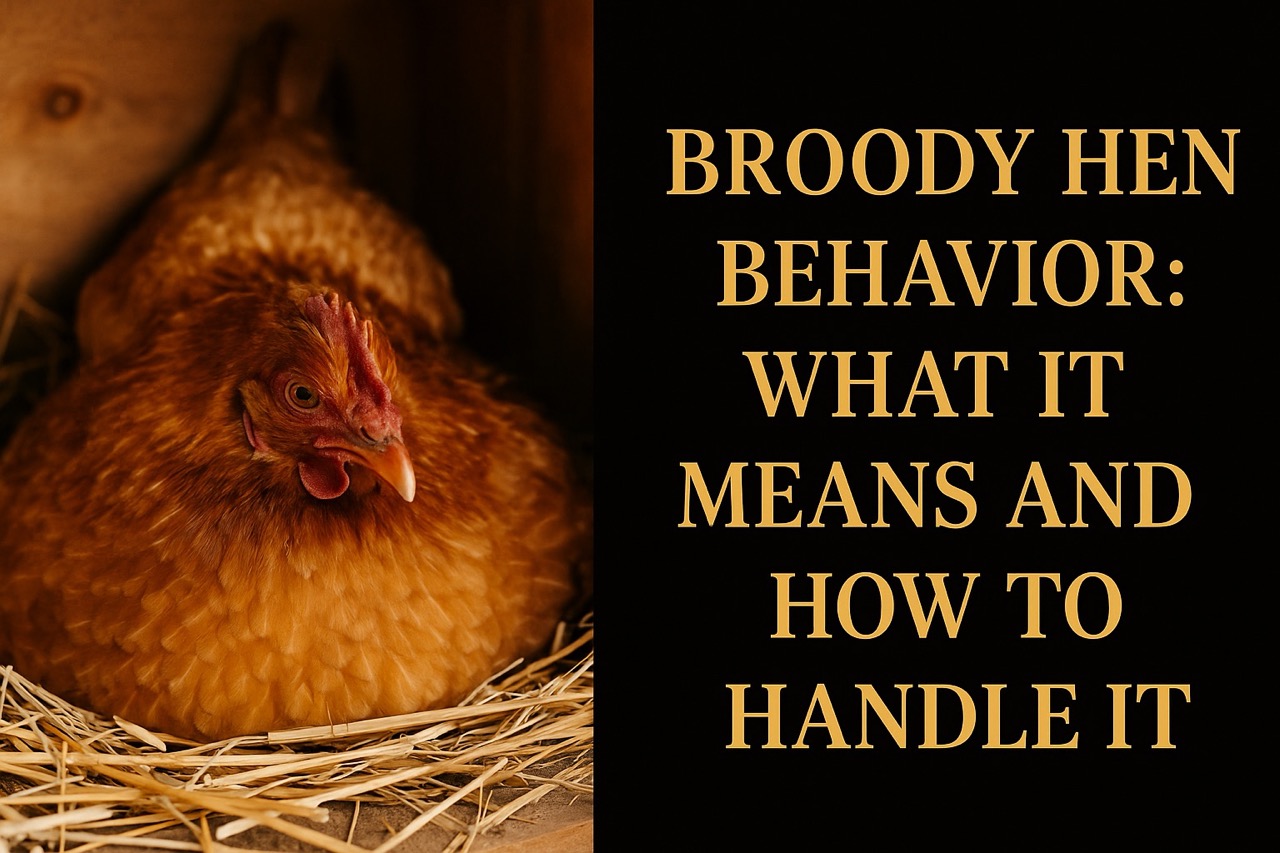Broody hen behavior refers to when a chicken’s natural instincts shift from laying eggs to hatching them. She’ll sit in the nest box for hours, puff up her feathers, growl when you come close, and often stop eating or laying altogether.
You might notice her sitting in the same spot all day, even without eggs underneath her. For first-time chicken keepers, this can be both confusing and frustrating — but it’s completely natural and manageable.
🐔 Want to understand the signs before they start? Read our full guide:
👉 Broody Hen Behavior – What It Means and How to Handle It
🔍 How to Tell If a Hen Is Broody
Here are key signs of broody hen behavior:
- Refuses to leave the nesting box — even at night
- Flattens over eggs or imaginary eggs
- Growls, hisses, or pecks when approached
- Missing chest feathers (she plucks them to warm eggs)
- Decreased appetite and water intake
- Stops laying eggs completely
If these symptoms sound familiar, you’ve got a broody bird on your hands.
🧬 Why Do Chickens Go Broody?
Broodiness is a natural reproductive cycle in hens. It’s caused by:
- Hormones: Triggered by warmer months and longer daylight
- Breed tendencies: Silkies, Orpingtons, and Cochins go broody often
- Environment: A quiet, cozy nesting box full of eggs encourages it
It’s not an illness — it’s instinct. But not all chickens go broody, especially hybrids like ISA Browns.
⚠️ The Risks of Broody Behavior
While broodiness isn’t dangerous by itself, it can cause problems if unmanaged:
- Weight loss & dehydration due to poor eating
- Egg production stops until hormones reset
- Aggression toward flockmates or you
- Clogged nest boxes if she hogs the space
- Futile exhaustion if no fertilized eggs are present
Unattended broody hens can become weak or depressed — and that affects the whole flock.
🛑 How to Stop Broody Hen Behavior
If you don’t want chicks, breaking the broody cycle is essential.
Here’s how to stop a broody hen:
- Collect eggs quickly to remove her motivation
- Physically remove her from the nest several times daily
- Use a wire-bottom crate with airflow under her belly — it cools her hormones
- Restrict access to the nesting area (especially at night)
- Provide distractions like free-ranging or treats
⏳ Most broody hens break the cycle within 3–5 days.
🐣 Want Chicks? Let Her Hatch!
If you have fertilized eggs and want to grow your flock, a broody hen can be a huge help.
Here’s how to let her hatch safely:
- Ensure she’s healthy and eating before setting eggs
- Mark or limit the eggs to avoid confusion
- Provide a separate space with food and water nearby
- Wait 21 days and avoid disrupting her too much
- Be ready with chick starter feed and brooder setup if needed
Natural hatching with a broody hen can be a beautiful, low-maintenance miracle.
✝ Faith Reflection: Even the Hens Know Their Season
“How often I have longed to gather your children together, as a hen gathers her chicks under her wings…” — Matthew 23:37
The broody hen offers more than behavior — she offers a picture of divine nurture. Like Christ longing to gather us in, a hen’s stillness reveals something sacred: protection, perseverance, and sacrificial love.
But even instinct needs wisdom. Stewardship means knowing when to support and when to intervene — for the good of all.
✅ Key Takeaway
Don’t ignore broody hen behavior. Whether you’re raising hens for eggs, companionship, or chicks, this is a crucial part of responsible flock care.
Understand her instincts. Support her when needed. Break the cycle when it’s harmful. Either way — you’re shaping a healthy, balanced flock.
🔗 Related Reading on Paranoid Prophet
- How Many Chickens to Start With
- Benefits of Raising Backyard Chickens
- Mental Health Perks of Chicken Keeping
- Chicken Dust Bath Guide
- Backyard Chickens for Kids
📖 Related Reading from Trusted Sources
- 🪺 How to Break a Broody Hen – Step-by-step methods from a homesteading expert, including safe and humane strategies.
https://gardenbetty.com/how-to-break-a-broody-hen/ - 🐥 Raising Chicks with a Broody Hen – A full guide to using your broody hen for natural hatching and chick care.
https://tlbacres.com/hatching-chicks-with-mother-hens/ - 🧊 5 Tips to Deal With a Broody Hen – Practical advice including crate cooling and flock-friendly distractions.
https://mannapro.com/blogs/news/5-tips-for-dealing-with-broody-hens - 💬 Community Thread: How to Break a Broody Hen – 1000+ comments from seasoned chicken keepers on what works and what doesn’t.
https://www.backyardchickens.com/threads/how-to-break-a-broody-hen.181289/ - 📚 Broodiness – Wikipedia Overview – A scientific and behavioral explanation of what causes broodiness in hens.
https://en.wikipedia.org/wiki/Broodiness - 🐓 How to Spot a Broody Hen & What To Do – Clear signs and actions to take from a UK-based poultry guide.
https://www.omlet.co.uk/guide/chickens/chicken_health/common_chicken_problems/ - 🌿 Grubbly Farms Guide: Breaking a Broody Hen – Focused on health, nutrition, and behavior.
https://grubblyfarms.com/blogs/the-flyer/how-to-break-a-broody-hen
❓ Frequently Asked Questions
Q: What causes a chicken to go broody?
A: Hormones and instinct — especially in certain breeds and seasons.
Q: How long does broodiness last?
A: About 21 days, or 3–5 days if you intervene to stop it.
Q: Is it bad for her health?
A: Yes, if she refuses to eat or move for extended periods.
Q: Can I move a broody hen to another spot?
A: Yes — especially for hatching. Move her at night to reduce stress.
Q: How do I stop her?
A: Use crate cooling, remove her from the nest, and distract her.
Q: Can I let her hatch chicks?
A: Absolutely — if you have fertilized eggs and a safe space.
Q: Will she return to normal?
A: Yes. After breaking or hatching, hens typically resume normal laying and behavior.




